Towards Sustainable Energy Development in Sub-Saharan Africa: Challenges and Opportunities
Abstract
:1. Introduction
2. Literature Review
3. Research Methodology
3.1. Research Sampling and Data Collection
3.2. Data Analysis Methods
4. Results
- Group 1: Cabo Verde, Mauritius, Seychelles and South Africa;
- Group 2: Burkina Faso, Guinea-Bissau, Liberia, Niger, Somalia, South Sudan and Chad;
- Group 3: Cote d’Ivoire, Gabon, Ghana, Nigeria, Sudan, Eswatini and Zimbabwe;
- Group 4: Botswana, Equatorial Guinea and Mauritania;
- Group 5: Benin, Comoros, Djibouti, Eritrea, Gambia, The Senegal, Sao Tome and Principe;
- Group 6: Burundi, Central African Republic, Democratic Republic of the Congo, Mozambique, Malawi, Uganda and Zambia;
- Group 7: Madagascar, Mali, Rwanda, Sierra Leone and Tanzania;
- Group 8: Cameroon, Ethiopia, Guinea, Kenya and Togo;
- Group 9: Angola, Republic of the Congo, Lesotho and Namibia.
- Group 1: Liberia, South Sudan, Rwanda and Lesotho;
- Group 2: Somalia, Comoros, Ethiopia, Kenya and Togo;
- Group 3: Burkina Faso, Ghana, Nigeria, Sudan, Benin, Djibouti, Eritrea, Sierra Leone and Cameroon;
- Group 4: Cabo Verde, Mauritius, Seychelles, South Africa, Cote d’Ivoire, Gabon, Zimbabwe, Equatorial Guinea, Sao Tome and Principe, Republic of the Congo and Namibia;
- Group 5: Guinea-Bissau, Chad, Mozambique, Uganda and Mali;
- Group 6: Niger, Eswatini, Botswana, Mauritania, Gambia, The Senegal, Burundi, Central African Republic, Democratic Republic of the Congo, Malawi, Zambia, Madagascar, Tanzania, Guinea and Angola.
5. Discussion
6. Conclusions
Author Contributions
Funding
Institutional Review Board Statement
Informed Consent Statement
Data Availability Statement
Conflicts of Interest
Appendix A


References
- Chirambo, D. Towards the achievement of SDG 7 in sub-Saharan Africa: Creating synergies between Power Africa, Sustainable Energy for All and climate finance in-order to achieve universal energy access before 2030. Renew. Sustain. Energy Rev. 2018, 94, 600–608. [Google Scholar] [CrossRef]
- Ilskog, E.; Kjellström, B. And then they lived sustainably ever after?—Assessment of rural electrification cases by means of indicators. Energy Policy 2008, 36, 2674–2684. [Google Scholar] [CrossRef]
- Olanrewaju, B.T.; Olubusoye, O.E.; Adenikinju, A.; Akintande, O.J. A panel data analysis of renewable energy consumption in Africa. Renew. Energy 2019, 140, 668–679. [Google Scholar] [CrossRef]
- Kumar, R.R.; Stauvermann, P.J.; Loganathan, N.; Kumar, R.D. Exploring the role of energy, trade and financial development in explaining economic growth in South Africa: A revisit. Renew. Sustain. Energy Rev. 2015, 52, 1300–1311. [Google Scholar] [CrossRef] [Green Version]
- Narayan, P.K.; Smyth, R. Multivariate granger causality between electricity consumption, exports and GDP: Evidence from a panel of Middle Eastern countries. Energy Policy 2009, 37, 229–236. [Google Scholar] [CrossRef]
- Narayan, P.K.; Smyth, R. Electricity consumption, employment and real income in Australia evidence from multivariate Granger causality tests. Energy Policy 2005, 33, 1109–1116. [Google Scholar] [CrossRef]
- Solarin, S.A.; Shahbaz, M. Trivariate causality between economic growth, urbanisation and electricity consumption in Angola: Cointegration and causality analysis. Energy Policy 2013, 60, 876–884. [Google Scholar] [CrossRef] [Green Version]
- Cotte Poveda, A.; Pardo Martínez, C.I. Trends in economic growth, poverty and energy in Colombia: Long-run and short-run effects. Energy Systems 2011, 2, 281–298. [Google Scholar] [CrossRef] [Green Version]
- Pueyo, A. What constrains renewable energy investment in Sub-Saharan Africa? A comparison of Kenya and Ghana. World Dev. 2018, 109, 85–100. [Google Scholar] [CrossRef]
- Taele, B.M.; Mokhutšoane, L.; Hapazari, I.; Tlali, S.B.; Senatla, M. Grid electrification challenges, photovoltaic electrification progress and energy sustainability in Lesotho. Renew. Sustain. Energy Rev. 2012, 16, 973–980. [Google Scholar] [CrossRef]
- Chakamera, C.; Alagidede, P. Electricity crisis and the effect of CO2 emissions on infrastructure-growth nexus in Sub Saharan Africa. Renew. Sustain. Energy Rev. 2018, 94, 945–958. [Google Scholar] [CrossRef]
- Luo, C.; Posen, I.; Hoornweg, D.; Maclean, H. Modelling future patterns of urbanization, residential energy use and greenhouse gas emissions in Dar es Salaam with the Shared Socio-Economic Pathways. J. Clean. Prod. 2020, 254, 119998. [Google Scholar] [CrossRef] [Green Version]
- Prasad, G. Improving access to energy in sub-Saharan Africa. Curr. Opin. Environ. Sustain. 2011, 3, 248–253. [Google Scholar] [CrossRef]
- Panos, E.; Turton, H.; Densing, M.; Volkart, K. Powering the growth of Sub-Saharan Africa: The Jazz and Symphony scenarios of World Energy Council. Energy Sustain. Dev. 2015, 26, 14–33. [Google Scholar] [CrossRef]
- Juju, D.; Baffoe, G.; Dam Lam, R.; Karanja, A.; Naidoo, M.; Ahmed, A.; Jarzebski, M.P.; Saito, O.; Fukushi, K.; Takeuchi, K.; et al. Sustainability Challenges in Sub-Saharan Africa in the Context of the Sustainable Development Goals (SDGs). In Sustainability Challenges in Sub-Saharan Africa I: Continental Perspectives and Insights from Western and Central Africa; Gasparatos, A., Ahmed, A., Naidoo, M., Karanja, A., Fukushi, K., Saito, O., Takeuchi, K., Eds.; Springer Singapore: Singapore, 2020; pp. 3–50. [Google Scholar]
- Ozcan, B.; Ozturk, I. Renewable energy consumption-economic growth nexus in emerging countries: A bootstrap panel causality test. Renew. Sustain. Energy Rev. 2019, 104, 30–37. [Google Scholar] [CrossRef]
- Adedoyin, F.F.; Ozturk, I.; Agboola, M.O.; Agboola, P.O.; Bekun, F.V. The implications of renewable and non-renewable energy generating in Sub-Saharan Africa: The role of economic policy uncertainties. Energy Policy 2021, 150, 112115. [Google Scholar] [CrossRef]
- Ebhota, W.; Tabakov, P.Y. Hydropower potentials and effects of poor manufacturing infrastructure on small hydropower development in Sub-Saharan Africa. Int. J. Energy Econ. Policy 2017, 7, 60–67. [Google Scholar]
- Suberu, M.Y.; Mustafa, M.W.; Bashir, N.; Muhamad, N.A.; Mokhtar, A.S. Power sector renewable energy integration for expanding access to electricity in sub-Saharan Africa. Renew. Sustain. Energy Rev. 2013, 25, 630–642. [Google Scholar] [CrossRef]
- Urbaniec, M. Sustainable competitiveness. Opportunities and challenges for Poland’s economy. Econ. Environ. 2016, 59, 34–51. [Google Scholar]
- Daudt, H.M.L.; van Mossel, C.; Scott, S.J. Enhancing the scoping study methodology: A large, inter-professional team’s experience with Arksey and O’Malley’s framework. BMC Med. Res. Methodol. 2013, 13, 48. [Google Scholar] [CrossRef] [PubMed] [Green Version]
- Peterson, J.; Pearce, P.F.; Ferguson, L.A.; Langford, C.A. Understanding scoping reviews: Definition, purpose, and process. J. Am. Assoc. Nurse Pract. 2017, 29, 12–16. [Google Scholar] [CrossRef]
- Munn, Z.; Peters, M.D.J.; Stern, C.; Tufanaru, C.; McArthur, A.; Aromataris, E. Systematic review or scoping review? Guidance for authors when choosing between a systematic or scoping review approach. BMC Med. Res. Methodol. 2018, 18, 1–7. [Google Scholar] [CrossRef] [PubMed]
- Arksey, H.; O’Malley, L. Scoping studies: Towards a methodological framework. Int. J. Soc. Res. Methodol. 2005, 8, 19–32. [Google Scholar] [CrossRef] [Green Version]
- D’Adamo, I.; Falcone, P.M.; Morone, P. A New Socio-economic Indicator to Measure the Performance of Bioeconomy Sectors in Europe. Ecol. Econ. 2020, 176, 106724. [Google Scholar] [CrossRef]
- Ikram, M. Models for Predicting Non-Renewable Energy Competing with Renewable Source for Sustainable Energy Development: Case of Asia and Oceania Region. Available online: https://link.springer.com/article/10.1007/s40171-021-00285-7 (accessed on 17 August 2021).
- Shyu, C.-W. A framework for ‘right to energy’ to meet UN SDG7: Policy implications to meet basic human energy needs, eradicate energy poverty, enhance energy justice, and uphold energy democracy. Energy Res. Soc. Sci. 2021, 79, 102199. [Google Scholar] [CrossRef]
- Garncarz, J.; Mierzejewski, M. The Impact of Crises on the Intellectual Capital of Companies in the Food Sector. e-Finanse 2019, 15, 1–9. [Google Scholar] [CrossRef] [Green Version]
- Piątkowski, M.J. Expectations and Challenges in the Labour Market in the Context of Industrial Revolution 4.0. The Agglomeration Method-Based Analysis for Poland and Other EU Member States. Sustainability 2020, 12, 5437. [Google Scholar] [CrossRef]
- Friedman, J.H. Greedy function approximation: A gradient boosting machine. Ann. Stat. 2001, 29, 1189–1232. [Google Scholar] [CrossRef]
- Friedman, J.H. Stochastic gradient boosting. Comput. Stat. Data Anal. 2002, 38, 367–378. [Google Scholar] [CrossRef]
- Hastie, T.; Tibshirani, R.; Friedman, J.H. The Elements of Statistical Learning: Data Mining, Inference, and Prediction; Springer: New York, NY, USA, 2001. [Google Scholar]
- Mpholo, M.; Mothala, M.; Mohasoa, L.; Eager, D.; Thamae, R.; Molapo, T.; Jardine, T. Lesotho electricity demand profile from 2010 to 2030. J. Energy South Afr. 2021, 32, 41–57. [Google Scholar] [CrossRef]
- Senatla, M.; Nchake, M.; Taele, B.M.; Hapazari, I. Electricity capacity expansion plan for Lesotho—Implications on energy policy. Energy Policy 2018, 120, 622–634. [Google Scholar] [CrossRef]
- Solarin, S.A.; Shahbaz, M.; Shahbaz, S.H. Revisiting the electricity consumption-economic growth nexus in Angola: The role of exports, imports and urbanization. Int. J. Energy Econ. Policy 2016, 6, 501–512. [Google Scholar]
- Surroop, D.; Raghoo, P. Renewable energy to improve energy situation in African island states. Renew. Sustain. Energy Rev. 2018, 88, 176–183. [Google Scholar] [CrossRef]
- Surroop, D.; Raghoo, P. Energy landscape in Mauritius. Renew. Sustain. Energy Rev. 2017, 73, 688–694. [Google Scholar] [CrossRef]
- Surroop, D.; Raghoo, P.; Bundhoo, Z.M.A. Comparison of energy systems in Small Island Developing States. Util. Policy 2018, 54, 46–54. [Google Scholar] [CrossRef]
- Tung, L.; Juliette, O. Towards a regional energy framework for African SIDS: Prospects and challenges. J. World Energy Law Bus. 2017, 10, 220–234. [Google Scholar] [CrossRef]
- Coutinho, G.L.; Vianna, J.N.; Dias, M.A. Alternatives for improving energy security in Cape Verde. Util. Policy 2020, 67, 101112. [Google Scholar] [CrossRef]
- An, J.; Mikhaylov, A. Russian energy projects in South Africa. J. Energy South Afr. 2020, 31, 58–64. [Google Scholar] [CrossRef]
- Denisova, V.; Mikhaylov, A.; Lopatin, E. Blockchain Infrastructure and Growth of Global Power Consumption. Int. J. Energy Econ. Policy 2019, 9, 22–29. [Google Scholar] [CrossRef]
- Bellos, E. Sustainable energy development: How can the tension between energy security and energy transition be measured and managed in South Africa? J. Clean. Prod. 2018, 205, 738–753. [Google Scholar] [CrossRef]
- Aliyu, A.K.; Modu, B.; Tan, C.W. A review of renewable energy development in Africa: A focus in South Africa, Egypt and Nigeria. Renew. Sustain. Energy Rev. 2018, 81, 2502–2518. [Google Scholar] [CrossRef]
- Winkler, H. Energy policies for sustainable development in South Africa. Energy Sustain. Dev. 2007, 11, 26–34. [Google Scholar] [CrossRef]
- McEwan, C. Spatial processes and politics of renewable energy transition: Land, zones and frictions in South Africa. Political Geogr. 2017, 56, 1–12. [Google Scholar] [CrossRef] [Green Version]
- Falchetta, G.; Dagnachew, A.G.; Hof, A.F.; Milne, D.J. The role of regulatory, market and governance risk for electricity access investment in sub-Saharan Africa. Energy Sustain. Dev. 2021, 62, 136–150. [Google Scholar] [CrossRef]
- Bishoge, O.; Kombe, G.; Mvile, B. Renewable energy for sustainable development in sub-Saharan African countries: Challenges and way forward. J. Renew. Sustain. Energy 2020, 12, 1–14. [Google Scholar] [CrossRef]
- Zalengera, C.; To, L.S.; Sieff, R.; Mohr, A.; Eales, A.; Cloke, J.; Buckland, H.; Brown, E.; Blanchard, R.; Batchelor, S. Decentralization: The key to accelerating access to distributed energy services in sub-Saharan Africa? J. Environ. Stud. Sci. 2020, 10, 270–289. [Google Scholar] [CrossRef]
- Hancock, K.J. The expanding horizon of renewable energy in sub-Saharan Africa: Leading research in the social sciences. Energy Res. Soc. Sci. 2015, 5, 1–8. [Google Scholar] [CrossRef]
- Urbaniec, M.; Tomala, J.; Martinez, S. Measurements and Trends in Technological Eco-Innovation: Evidence from Environment-Related Patents. Resources 2021, 10, 68. [Google Scholar] [CrossRef]
- Mainali, B.; Luukkanen, J.; Silveira, S.; Kaivo-oja, J. Evaluating Synergies and Trade-Offs among Sustainable Development Goals (SDGs): Explorative Analyses of Development Paths in South Asia and Sub-Saharan Africa. Sustainability 2018, 10, 815. [Google Scholar] [CrossRef] [Green Version]


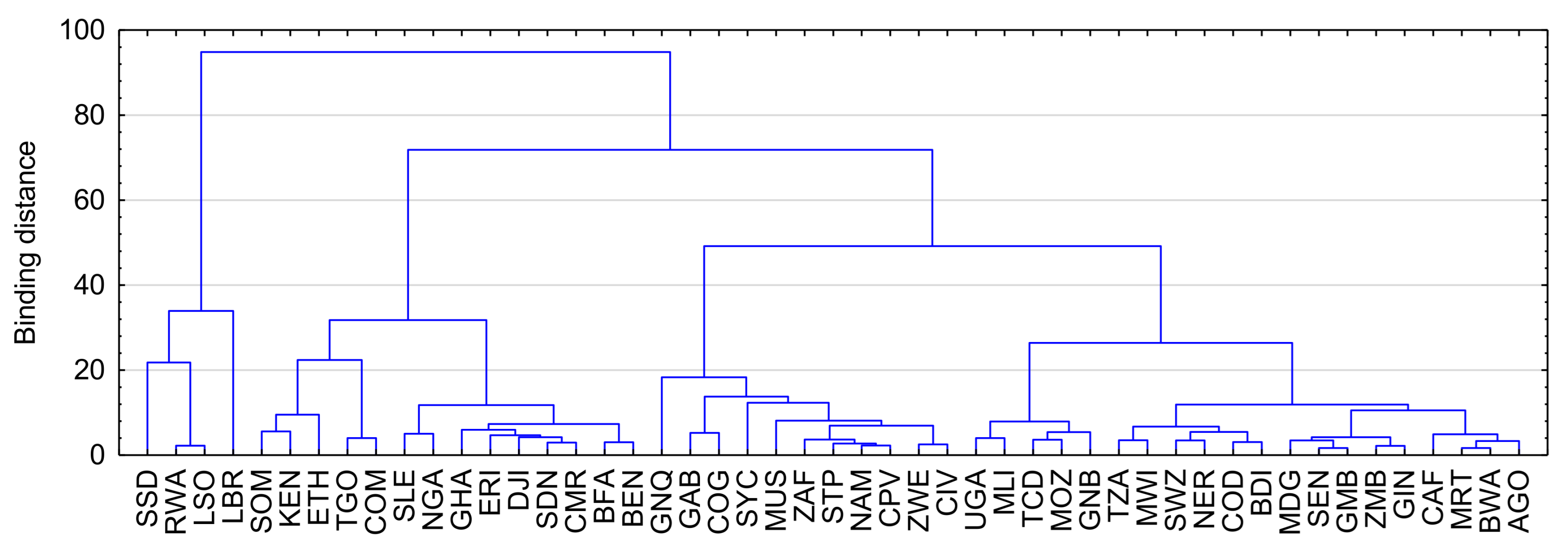
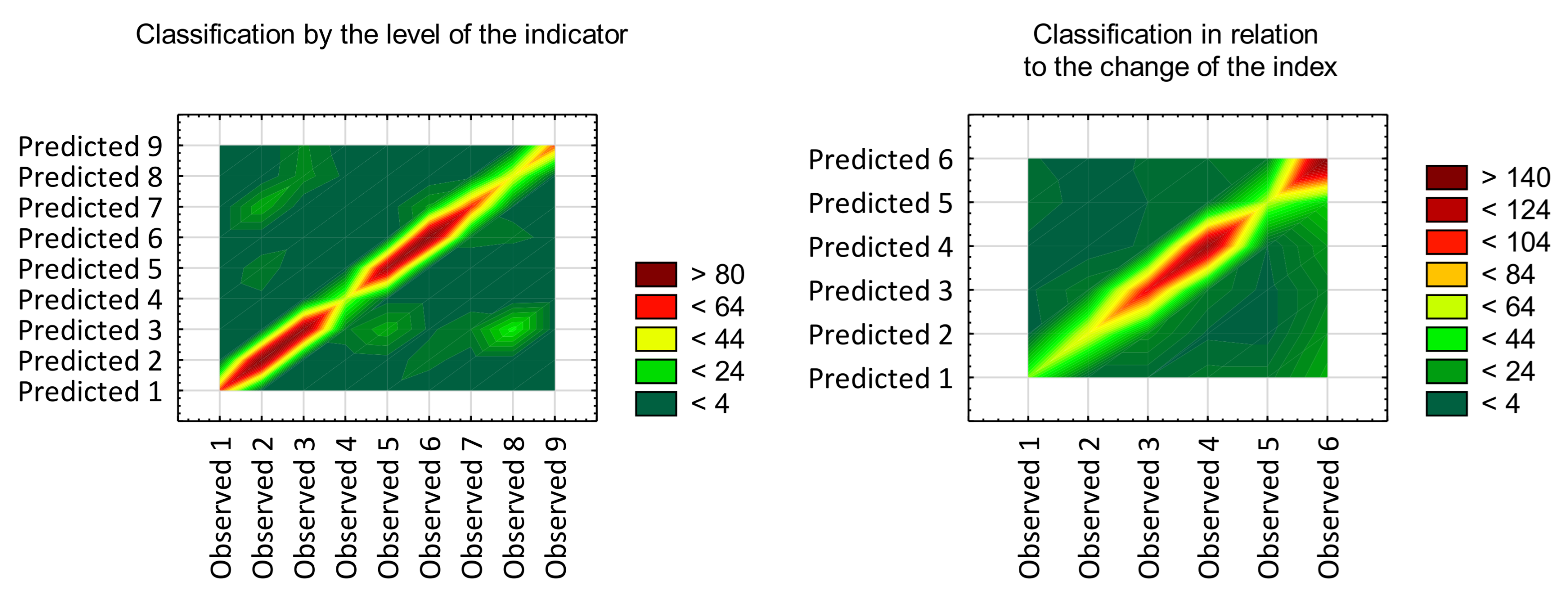
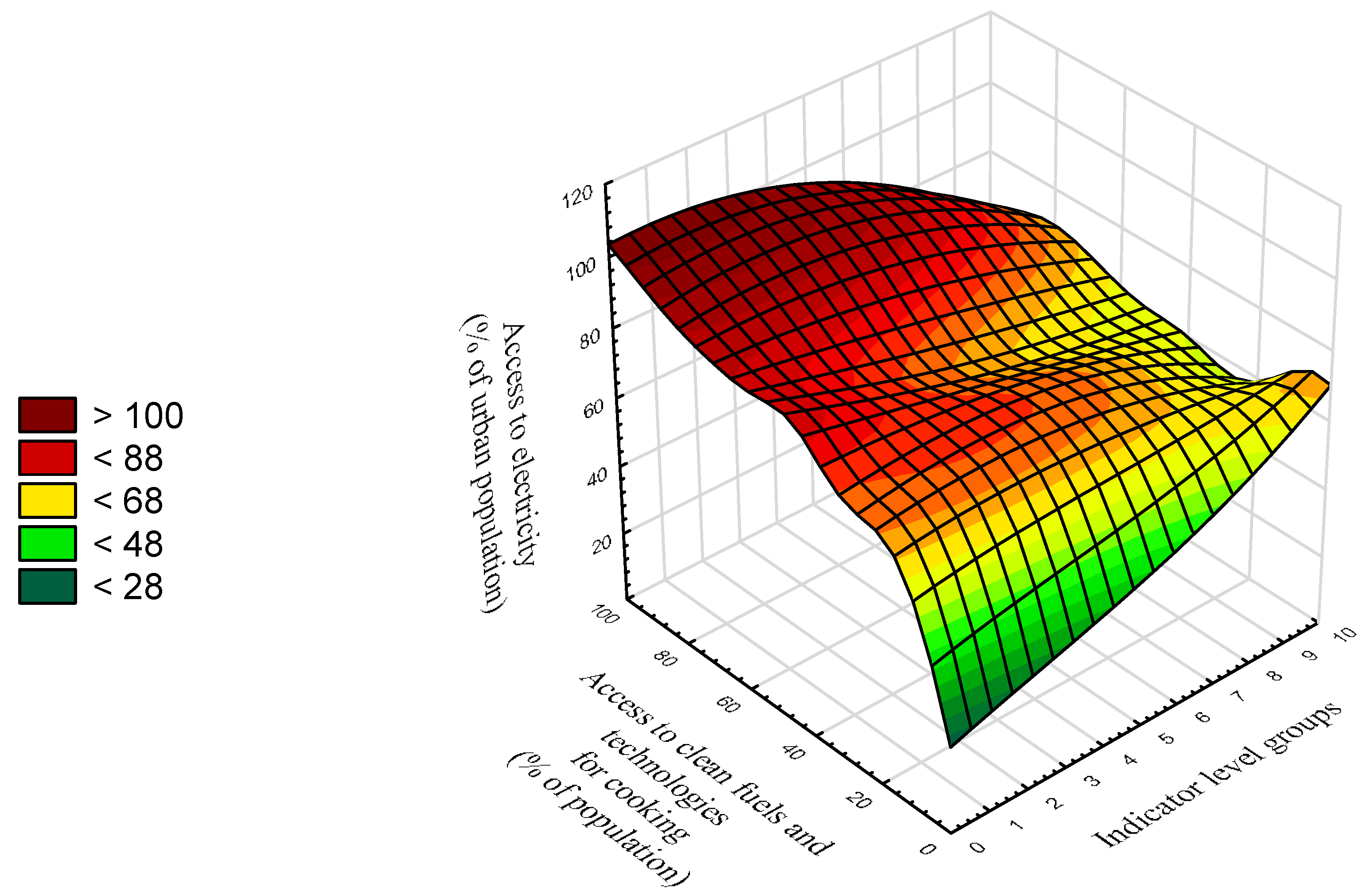
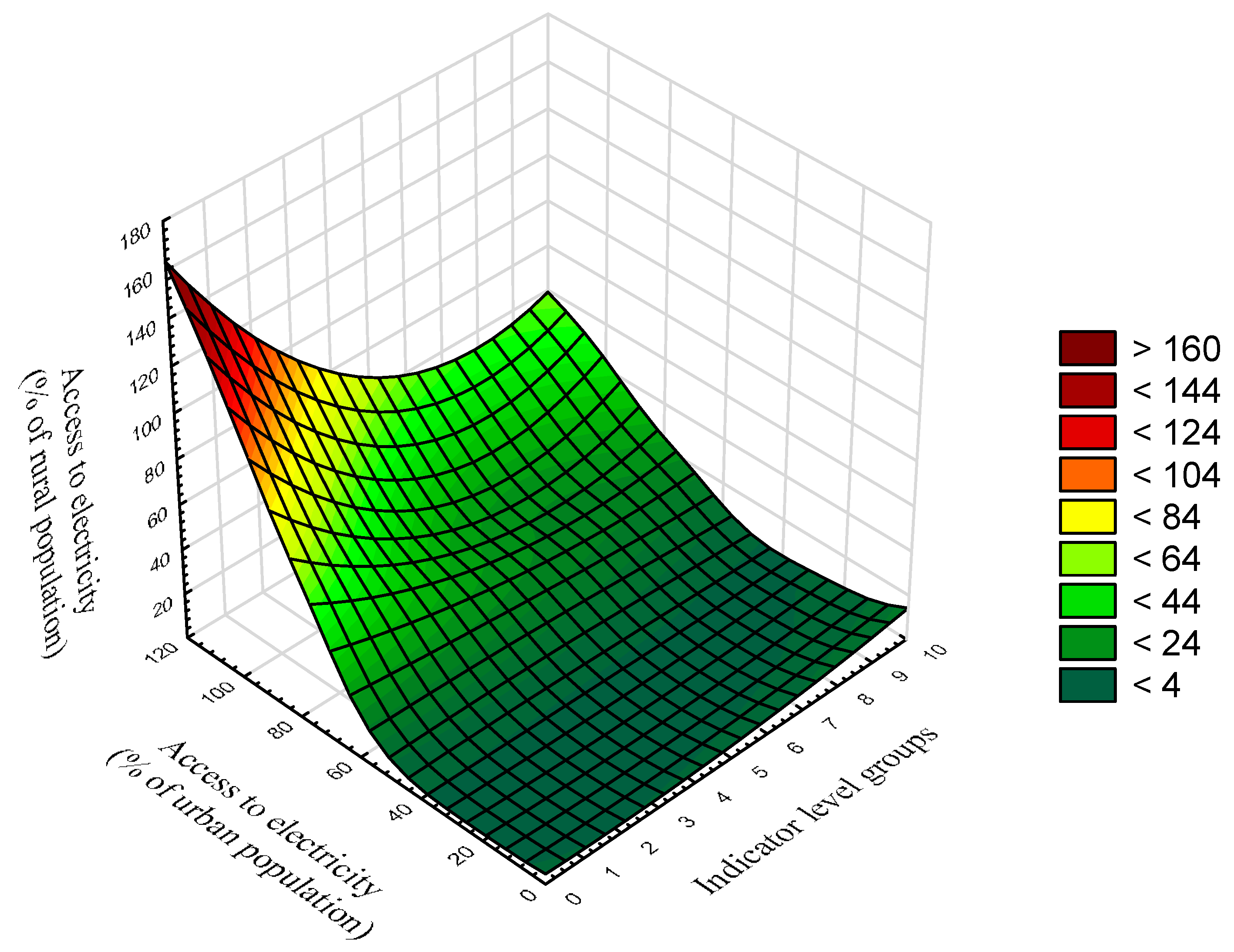
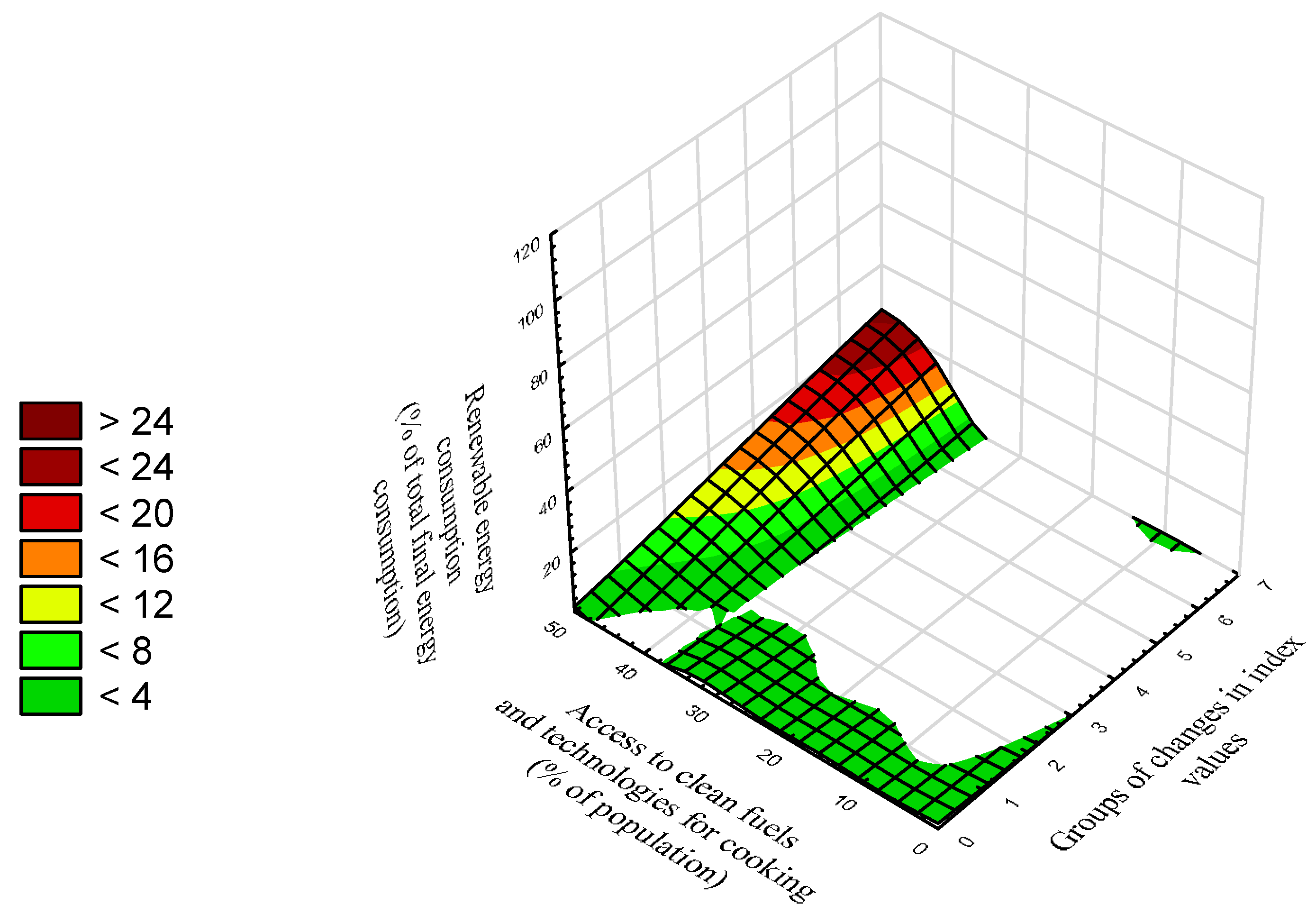
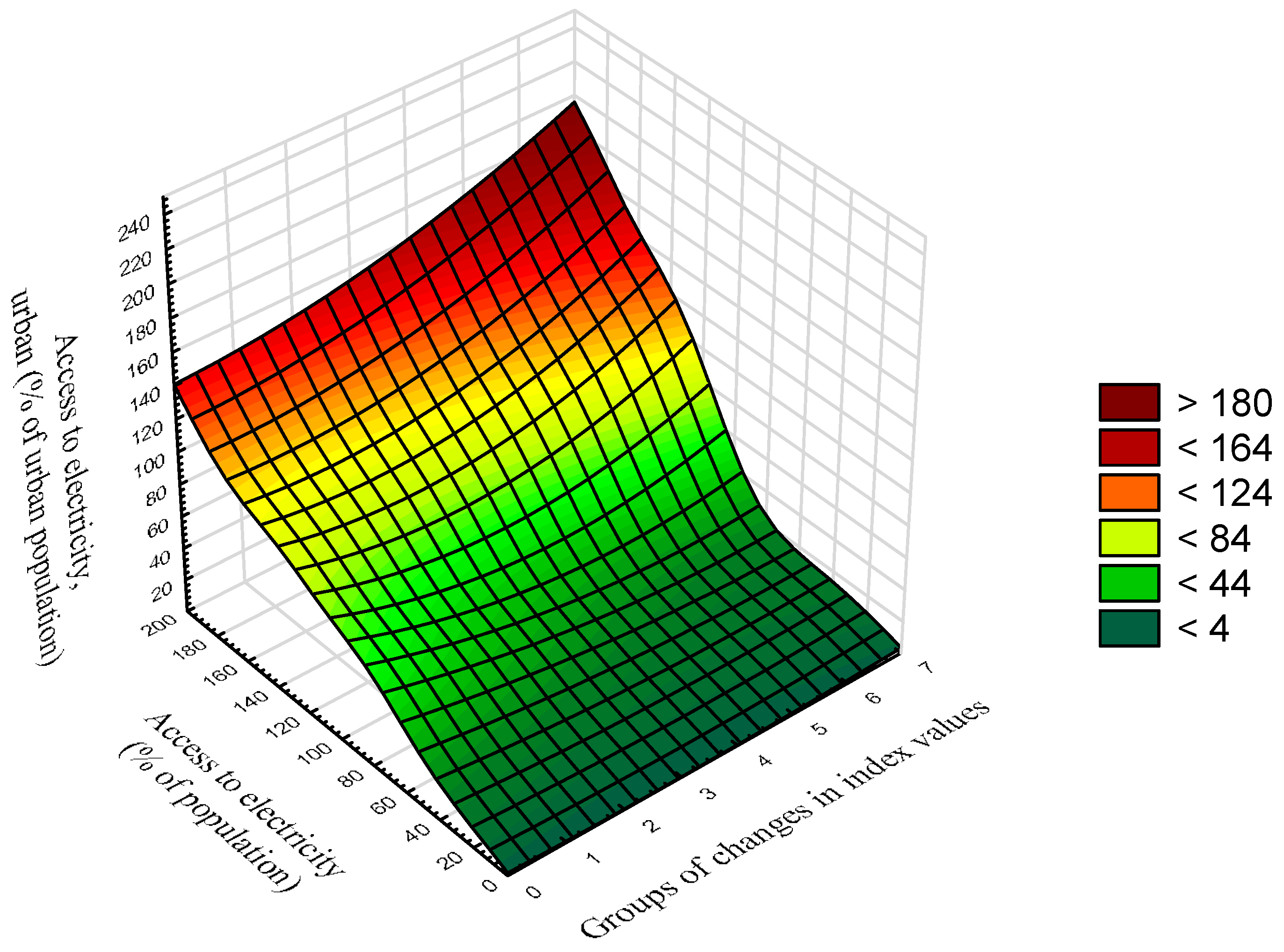
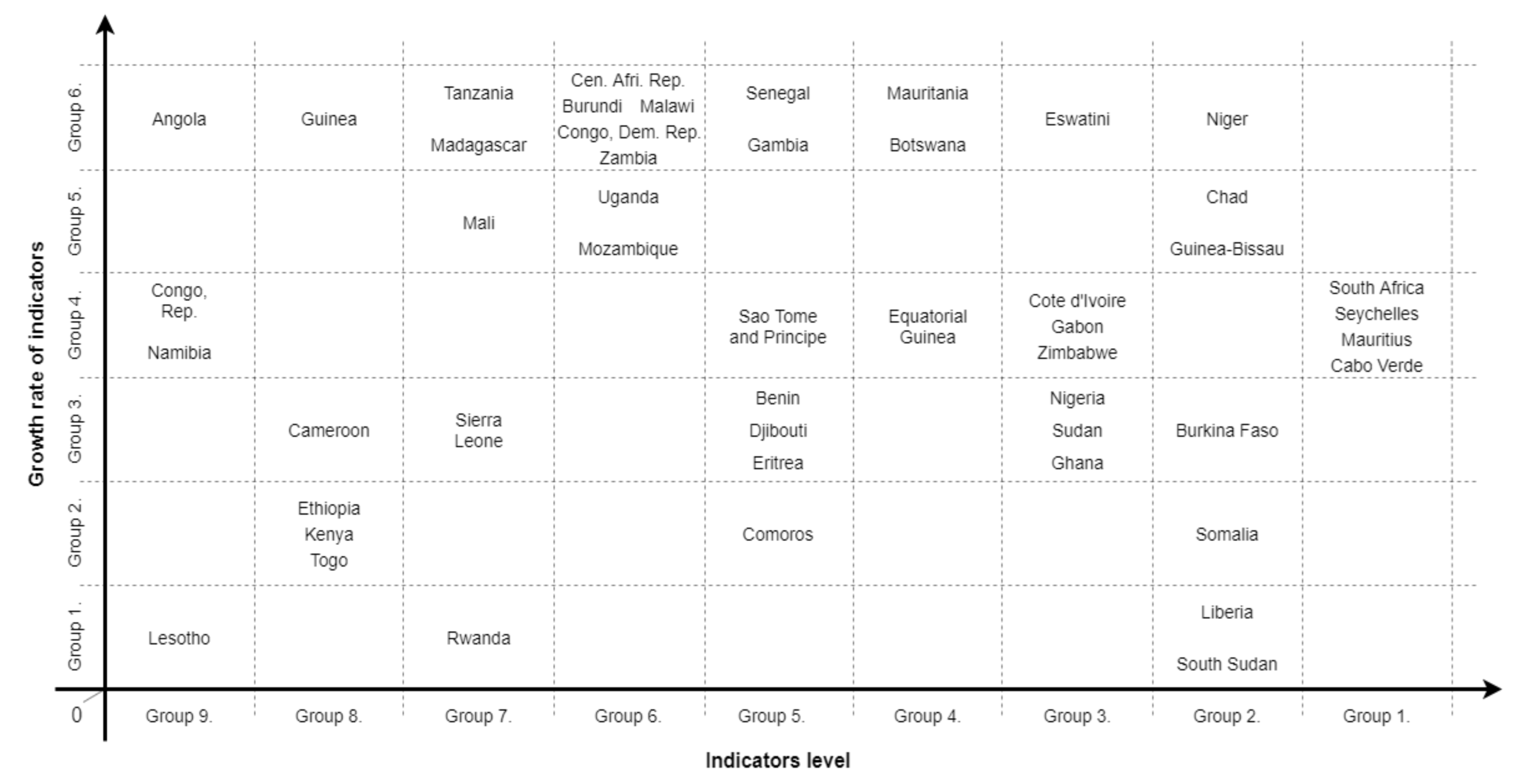
| Source | No. of Articles |
|---|---|
| Renewable and Sustainable Energy Reviews | 2 |
| Current Opinion on Environmental Sustainability | 1 |
| Energy For Sustainable Development | 1 |
| Energy Policy | 1 |
| International Journal of Energy Economics and Policy | 1 |
| Journal of Cleaner Production | 1 |
| World Development | 1 |
| SDG Target | SDG Indicator | Indicator Name | Long Definition | Source | License URL |
|---|---|---|---|---|---|
| Target 7.1: By 2030, ensure universal access to affordable, reliable and modern energy services | Indicator 7.1.1: Proportion of population with access to electricity | Access to electricity (% of population) | Access to electricity is the percentage of population with access to electricity. Electrification data are collected from industry, national surveys and international sources. | World Bank, Sustainable Energy for All (SE4ALL) database from the SE4ALL Global Tracking Framework led jointly by the World Bank, International Energy Agency and the Energy Sector Management Assistance Program. | https://datacatalog.worldbank.org/public-licenses#cc-by (accessed on 3 August 2021). |
| Access to electricity, rural (% of rural population) | Access to electricity, rural is the percentage of the rural population with access to electricity. | World Bank, Sustainable Energy for All (SE4ALL) database from the SE4ALL Global Tracking Framework led jointly by the World Bank, International Energy Agency and the Energy Sector Management Assistance Program. | https://datacatalog.worldbank.org/public-licenses#cc-by (accessed on 3 August 2021). | ||
| Access to electricity, urban (% of urban population) | Access to electricity, urban is the percentage of the urban population with access to electricity. | World Bank, Sustainable Energy for All (SE4ALL) database from the SE4ALL Global Tracking Framework led jointly by the World Bank, International Energy Agency and the Energy Sector Management Assistance Program. | https://datacatalog.worldbank.org/public-licenses#cc-by (accessed on 3 August 2021). | ||
| Indicator 7.1.2: Proportion of population with primary reliance on clean fuels and technology | Access to clean fuels and technologies for cooking (% of population) | Access to clean fuels and technologies for cooking is the proportion of total population primarily using clean cooking fuels and technologies for cooking. Under WHO guidelines, kerosene is excluded from clean cooking fuels. | World Bank, Sustainable Energy for All (SE4ALL) database from WHO Global Household Energy database. | https://datacatalog.worldbank.org/public-licenses#cc-by (accessed on 3 August 2021). | |
| Target 7.2: By 2030, substantially increase the share of renewable energy in the global energy mix | Indicator 7.2.1 (supplement): Renewable energy share of total final energy consumption | Renewable electricity output (% of total electricity output) | Renewable electricity is the share of electricity generated by renewable power plants of the overall electricity generated by all types of plants. | IEA Statistics © OECD/IEA 2018 (http://www.iea.org/stats/index.asp (accessed on 3 August 2021)), subject to https://www.iea.org/t&c/termsandconditions/ (accessed on 3 August 2021). | http://www.iea.org/t&c/termsandconditions (accessed on 3 August 2021). |
| Indicator 7.2.1: Renewable energy share of total final energy consumption | Renewable energy consumption (% of total final energy consumption) | Renewable energy consumption is the share of renewable energy of total final energy consumption. | World Bank, Sustainable Energy for All (SE4ALL) database from the SE4ALL Global Tracking Framework led jointly by the World Bank, International Energy Agency, and the Energy Sector Management Assistance Program. | https://datacatalog.worldbank.org/public-licenses#cc-by (accessed on 3 August 2021). | |
| Target 7.3: By 2030, double the global rate of improvement in energy efficiency | Indicator 7.3.1: Energy intensity measured in terms of primary energy and GDP | Energy intensity level of primary energy (MJ/$2011 PPP GDP) | Energy intensity level of primary energy is the ratio between energy supply and gross domestic product measured at purchasing power parity. Energy intensity is an indication of how much energy is used to produce one unit of economic output. A lower ratio indicates that less energy is used to produce one unit of output. | World Bank, Sustainable Energy for All (SE4ALL) database from the SE4ALL Global Tracking Framework led jointly by the World Bank, International Energy Agency and the Energy Sector Management Assistance Program. | https://datacatalog.worldbank.org/public-licenses#cc-by (accessed on 3 August 2021). |
| Indicator | Validity for Quantity | Validity for Change |
|---|---|---|
| Access to clean fuels and technologies for cooking (% of population) | 1.00 | 1.00 |
| Access to electricity (% of population) | 0.90 | 0.98 |
| Access to electricity, rural (% of rural population) | 0.81 | 0.75 |
| Access to electricity, urban (% of urban population) | 0.82 | 1.00 |
| Energy intensity level of primary energy (MJ/$2011 PPP GDP) | 0.70 | 0.67 |
| Renewable electricity output (% of total electricity output) | 0.70 | 0.67 |
| Renewable energy consumption (% of total final energy consumption) | 0.80 | 0.75 |
Publisher’s Note: MDPI stays neutral with regard to jurisdictional claims in published maps and institutional affiliations. |
© 2021 by the authors. Licensee MDPI, Basel, Switzerland. This article is an open access article distributed under the terms and conditions of the Creative Commons Attribution (CC BY) license (https://creativecommons.org/licenses/by/4.0/).
Share and Cite
Tomala, J.; Mierzejewski, M.; Urbaniec, M.; Martinez, S. Towards Sustainable Energy Development in Sub-Saharan Africa: Challenges and Opportunities. Energies 2021, 14, 6037. https://doi.org/10.3390/en14196037
Tomala J, Mierzejewski M, Urbaniec M, Martinez S. Towards Sustainable Energy Development in Sub-Saharan Africa: Challenges and Opportunities. Energies. 2021; 14(19):6037. https://doi.org/10.3390/en14196037
Chicago/Turabian StyleTomala, Justyna, Mateusz Mierzejewski, Maria Urbaniec, and Sergio Martinez. 2021. "Towards Sustainable Energy Development in Sub-Saharan Africa: Challenges and Opportunities" Energies 14, no. 19: 6037. https://doi.org/10.3390/en14196037
APA StyleTomala, J., Mierzejewski, M., Urbaniec, M., & Martinez, S. (2021). Towards Sustainable Energy Development in Sub-Saharan Africa: Challenges and Opportunities. Energies, 14(19), 6037. https://doi.org/10.3390/en14196037







